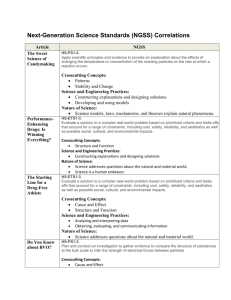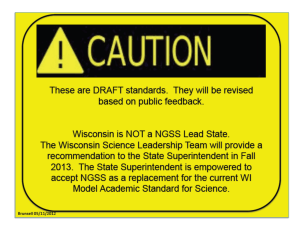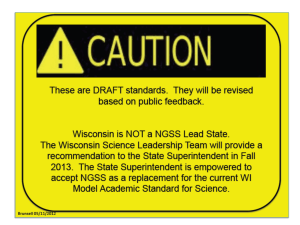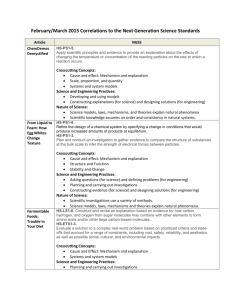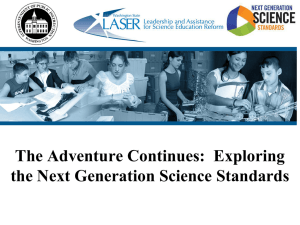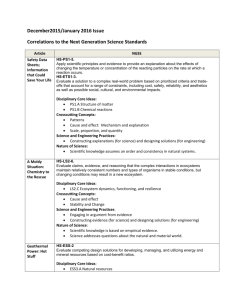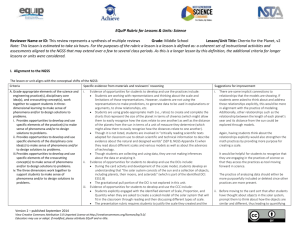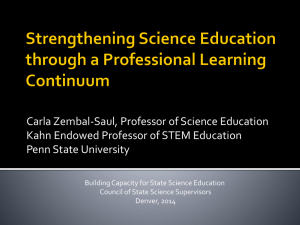Word - Next Generation Science Standards
advertisement
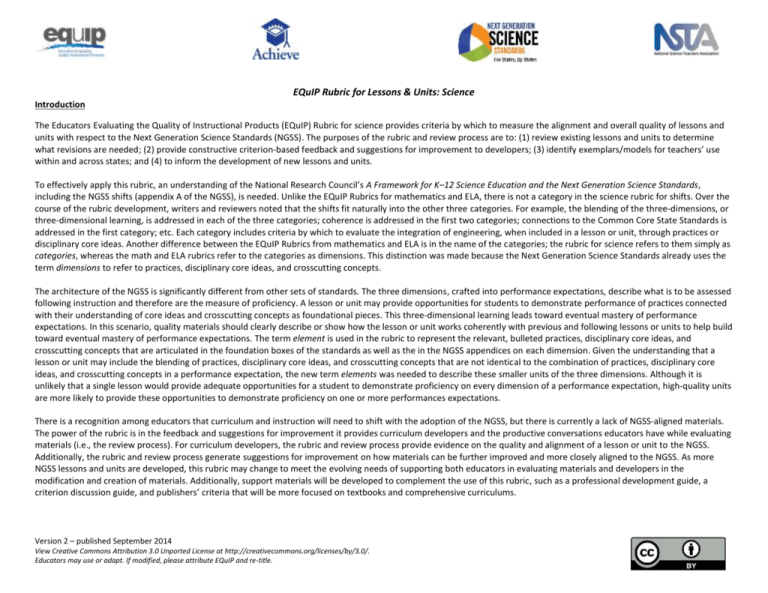
EQuIP Rubric for Lessons & Units: Science Introduction The Educators Evaluating the Quality of Instructional Products (EQuIP) Rubric for science provides criteria by which to measure the alignment and overall quality of lessons and units with respect to the Next Generation Science Standards (NGSS). The purposes of the rubric and review process are to: (1) review existing lessons and units to determine what revisions are needed; (2) provide constructive criterion-based feedback and suggestions for improvement to developers; (3) identify exemplars/models for teachers’ use within and across states; and (4) to inform the development of new lessons and units. To effectively apply this rubric, an understanding of the National Research Council’s A Framework for K–12 Science Education and the Next Generation Science Standards, including the NGSS shifts (appendix A of the NGSS), is needed. Unlike the EQuIP Rubrics for mathematics and ELA, there is not a category in the science rubric for shifts. Over the course of the rubric development, writers and reviewers noted that the shifts fit naturally into the other three categories. For example, the blending of the three-dimensions, or three-dimensional learning, is addressed in each of the three categories; coherence is addressed in the first two categories; connections to the Common Core State Standards is addressed in the first category; etc. Each category includes criteria by which to evaluate the integration of engineering, when included in a lesson or unit, through practices or disciplinary core ideas. Another difference between the EQuIP Rubrics from mathematics and ELA is in the name of the categories; the rubric for science refers to them simply as categories, whereas the math and ELA rubrics refer to the categories as dimensions. This distinction was made because the Next Generation Science Standards already uses the term dimensions to refer to practices, disciplinary core ideas, and crosscutting concepts. The architecture of the NGSS is significantly different from other sets of standards. The three dimensions, crafted into performance expectations, describe what is to be assessed following instruction and therefore are the measure of proficiency. A lesson or unit may provide opportunities for students to demonstrate performance of practices connected with their understanding of core ideas and crosscutting concepts as foundational pieces. This three-dimensional learning leads toward eventual mastery of performance expectations. In this scenario, quality materials should clearly describe or show how the lesson or unit works coherently with previous and following lessons or units to help build toward eventual mastery of performance expectations. The term element is used in the rubric to represent the relevant, bulleted practices, disciplinary core ideas, and crosscutting concepts that are articulated in the foundation boxes of the standards as well as the in the NGSS appendices on each dimension. Given the understanding that a lesson or unit may include the blending of practices, disciplinary core ideas, and crosscutting concepts that are not identical to the combination of practices, disciplinary core ideas, and crosscutting concepts in a performance expectation, the new term elements was needed to describe these smaller units of the three dimensions. Although it is unlikely that a single lesson would provide adequate opportunities for a student to demonstrate proficiency on every dimension of a performance expectation, high-quality units are more likely to provide these opportunities to demonstrate proficiency on one or more performances expectations. There is a recognition among educators that curriculum and instruction will need to shift with the adoption of the NGSS, but there is currently a lack of NGSS-aligned materials. The power of the rubric is in the feedback and suggestions for improvement it provides curriculum developers and the productive conversations educators have while evaluating materials (i.e., the review process). For curriculum developers, the rubric and review process provide evidence on the quality and alignment of a lesson or unit to the NGSS. Additionally, the rubric and review process generate suggestions for improvement on how materials can be further improved and more closely aligned to the NGSS. As more NGSS lessons and units are developed, this rubric may change to meet the evolving needs of supporting both educators in evaluating materials and developers in the modification and creation of materials. Additionally, support materials will be developed to complement the use of this rubric, such as a professional development guide, a criterion discussion guide, and publishers’ criteria that will be more focused on textbooks and comprehensive curriculums. Version 2 – published September 2014 View Creative Commons Attribution 3.0 Unported License at http://creativecommons.org/licenses/by/3.0/. Educators may use or adapt. If modified, please attribute EQuIP and re-title. Directions The first step in the review process is to become familiar with the rubric, the lesson or unit, and the practices, disciplinary core ideas, and crosscutting concepts targeted in the lesson or unit. The three categories in the rubric correspond to: alignment to the NGSS, instructional supports, and monitoring student progress. Specific criteria within each category should be considered separately as part of the complete review process and are used to provide sufficient information for determination of overall quality of the lesson or unit. For the purposes of using the rubric, a lesson is defined as: a coherent set of instructional activities and assessments aligned to the NGSS that may extend over a few to several class periods or days and a unit is defined as: coherent set of lessons aligned to the NGSS that extend over a longer period of time. Also important to the review process is feedback and suggestions for improvement to the developer of the resource. For this purpose a set of response forms is included so that the reviewer can effectively provide criterion-based feedback and suggestions for improvement for each category. The response forms correspond to the criteria of the rubric. Evidence for each criterion must be identified and documented and criterion-based feedback and suggestions for improvement should be given to help improve the lesson or unit. While it is possible for the rubric to be applied by an individual, the quality review process works best with a team of reviewers, as a collaborative process, with the individuals recording their thoughts and then discussing with other team members before finalizing their feedback and suggestions for improvement. Discussions should focus on understanding all reviewers’ interpretations of the criteria and the evidence they have found. The goal of the process is to eventually calibrate responses across reviewers and to move toward agreement about quality with respect to the NGSS. Commentary needs to be constructive, with all lessons or units considered “works in progress.” Reviewers must be respectful of team members and the resource contributor. Contributors should see the review process as an opportunity to gather feedback and suggestions for improvement rather than to advocate for their work. All feedback and suggestions for improvement should be criterion-based and have supporting evidence from the lesson or unit cited. Note: This rubric will eventually have scoring guidelines for each category, as well as for an overall rating. However, given the current lack of NGSS-aligned materials, rather than focusing on ratings at this point in time, the focus should be on becoming familiar with the rubric and using it to provide criterion-based feedback and suggestions for improvement to developers and make revisions to existing materials. Step 1 – Review Materials The first step in the review process is to become familiar with the rubric, the lesson or unit, and the practices, disciplinary core ideas, and crosscutting concepts targeted in the lesson or unit. Review the rubric and record the grade and title of the lesson or unit on the response form. Scan to see what the lesson or unit contains, what practices, disciplinary core ideas, and crosscutting concepts are targeted, and how it is organized. Read key materials related to instruction, assessment, and teacher guidance. Step 2 – Apply Criteria in Category I: Alignment to the NGSS The second step is to evaluate the lesson or unit using the criteria in the first category, first individually and then as a team. Closely examine the lesson or unit through the “lens” of each criterion in the first category of the response form. Individually check each criterion on the response form for which clear and substantial evidence is found and record the evidence and reasoning. As a team, discuss criteria for which clear and substantial evidence is found, as well as criterion-based suggestions for specific improvements that might be needed to meet criteria. If the lesson or unit is not closely aligned to the Next Generation Science Standards, it may not be appropriate to move on to the second and third categories. Professional judgment should be used when weighing the individual criterion. For example, a lesson without crosscutting concepts explicitly called out may be easier to revise than one without appropriate disciplinary core ideas; such a difference may determine whether reviewers believe the lesson merits continued evaluation or not. Step 3 – Apply Criteria in Categories II and III: Instructional Supports and Monitoring Student Progress The third step is to evaluate the lesson or unit using the criteria in the second and third categories, first individually and then as a group. Closely examine the lesson or unit through the “lens” of each criterion in the second and third categories of the response form. 2 Individually check each criterion on the response form for which clear and substantial evidence is found and record the evidence and reasoning. As a team, discuss criteria for which clear and substantial evidence is found, as well as criterion-based suggestions for specific improvements that might be needed to meet criteria. When working in a group, teams may choose to compare ratings after each category or delay conversation until each person has rated and recorded input for the two remaining categories. Complete consensus among team members is not required but discussion is a key component of the review process. 3 EQuIP Rubric for Lessons & Units: Science I. Alignment to the NGSS II. Instructional Supports III. Monitoring Student Progress The lesson or unit aligns with the conceptual shifts of the NGSS: A. Grade-appropriate elements of the science and engineering practice(s), disciplinary core idea(s), and crosscutting concept(s), work together to support students in three-dimensional learning to make sense of phenomena and/or to design solutions to problems. i. Provides opportunities to develop and use specific elements of the practice(s) to make sense of phenomena and/or to design solutions to problems. ii. Provides opportunities to develop and use specific elements of the disciplinary core idea(s) to make sense of phenomena and/or to design solutions to problems. iii. Provides opportunities to develop and use specific elements of the crosscutting concept(s) to make sense of phenomena and/or to design solutions to problems. iv. The three dimensions work together to support students to make sense of phenomena and/or to design solutions to problems. The lesson or unit supports instruction and learning for all students: A. Engages students in authentic and meaningful scenarios that reflect the practice of science and engineering as experienced in the real world and that provide students with a purpose (e.g., making sense of phenomena and/or designing solutions to problems). i. The context, including phenomena, questions, or problems, motivates students to engage in three-dimensional learning. ii. Provides students with relevant phenomena (either firsthand experiences or through representations) to make sense of and/or relevant problems to solve. iii. Engages students in multiple practices that work together with disciplinary core ideas and crosscutting concepts to support students in making sense of phenomena and/or designing solutions to problems. iv. Provides opportunities for students to connect their explanation of a phenomenon and/or their design solution to a problem to their own experience. v. When engineering performance expectations are included, they are used along with disciplinary core ideas from physical, life, or earth and space sciences. B. Develops deeper understanding of the practices, disciplinary core ideas, and crosscutting concepts by identifying and building on students’ prior knowledge. C. Uses scientifically accurate and grade-appropriate scientific information, phenomena, and representations to support students’ three-dimensional learning. D. Provides opportunities for students to express, clarify, justify, interpret, and represent their ideas and respond to peer and teacher feedback orally and/or in written form as appropriate to support student’s three-dimensional learning. E. Provides guidance for teachers to support differentiated instruction in the classroom so that every student’s needs are addressed by including: i. Suggestions for how to connect instruction to the students' home, neighborhood, community and/or culture as appropriate. ii. Appropriate reading, writing, listening, and/or speaking alternatives (e.g., translations, picture support, graphic organizers) for students who are English language learners, have special needs, or read well below the grade level. iii. Suggested extra support (e.g., phenomena, representations, tasks) for students who are struggling to meet the performance expectations. iv. Extensions for students with high interest or who have already met the performance expectations to develop deeper understanding of the practices, disciplinary core ideas, and crosscutting concepts. The lesson or unit supports monitoring student progress: A. Elicits direct, observable evidence of threedimensional learning by students using practices with core ideas and crosscutting concepts to make sense of phenomena and/or to design solutions. B. Formative assessments of three-dimensional learning are embedded throughout the instruction. C. Includes aligned rubrics and scoring guidelines that provide guidance for interpreting student performance along the three dimensions to support teachers in (a) planning instruction and (b) providing ongoing feedback to students. D. Assessing student proficiency using methods, vocabulary, representations, and examples that are accessible and unbiased for all students. A unit or longer lesson will also: B. Lessons fit together coherently targeting a set of performance expectations. i. Each lesson links to previous lessons and provides a need to engage in the current lesson. ii. The lessons help students develop proficiency on a targeted set of performance expectations. C. Where appropriate, disciplinary core ideas from different disciplines are used together to explain phenomena. D. Where appropriate, crosscutting concepts are used in the explanation of phenomena from a variety of disciplines. E. Provides grade-appropriate connection(s) to the Common Core State Standards in Mathematics and/or English Language Arts & Literacy in History/Social Studies, Science and Technical Subjects. A unit or longer lesson will also: E. Includes pre-, formative, summative, and self-assessment measures that assess threedimensional learning. F. Provides multiple opportunities for students to demonstrate performance of practices connected with their understanding of disciplinary core ideas and crosscutting concepts and receive feedback. A unit or longer lesson will also: F. Provides guidance for teachers throughout the unit for how lessons build on each other to support students developing deeper understanding of the practices, disciplinary core ideas, and crosscutting concepts over the course of the unit. G. Provides supports to help students engage in the practices as needed and gradually adjusts supports over time so that students are increasingly responsible for making sense of phenomena and/or designing solutions to problems. 4 EQuIP Rubric for Lessons & Units: Science Reviewer Name or ID: Grade: Lesson/Unit Title: I. Alignment to the NGSS The lesson or unit aligns with the conceptual shifts of the NGSS: Criteria Specific evidence from materials and reviewers’ reasoning Suggestions for improvement Specific evidence from materials and reviewers’ reasoning Suggestions for improvement ☐ A. Grade-appropriate elements of the science and engineering practice(s), disciplinary core idea(s), and crosscutting concept(s), work together to support students in three-dimensional learning to make sense of phenomena and/or to design solutions to problems. i. Provides opportunities to develop and use specific elements of the practice(s) to make sense of phenomena and/or to design solutions to problems. ii. Provides opportunities to develop and use specific elements of the disciplinary core idea(s) to make sense of phenomena and/or to design solutions to problems. iii. Provides opportunities to develop and use specific elements of the crosscutting concept(s) to make sense of phenomena and/or to design solutions to problems. iv. The three dimensions work together to support students to make sense of phenomena and/or to design solutions to problems. A unit or longer lesson will also: Criteria ☐ B. Lessons fit together coherently targeting a set of performance expectations. i. Each lesson links to previous lessons and provides a need to engage in the current lesson. ii. The lessons help students develop proficiency on a targeted set of performance expectations. ☐ C. Where appropriate, disciplinary core ideas from different disciplines are used together to explain phenomena. ☐ D. Where appropriate, crosscutting concepts are used in the explanation of phenomena from a variety of disciplines. ☐ E. Provides grade-appropriate connection(s) to the Common Core State Standards in Mathematics and/or English Language Arts & Literacy in History/Social Studies, Science and Technical Subjects. If the lesson or unit is not closely aligned to the Next Generation Science Standards, it may not be appropriate to move on to the second and third categories. Professional judgment should be used when weighing the individual criterion. For example, a lesson without crosscutting concepts explicitly called out may be easier to revise than one without appropriate disciplinary core ideas; such a difference may determine whether reviewers believe the lesson merits continued evaluation or not. 5 II. Instructional Supports The lesson or unit supports instruction and learning for all students: Criteria Specific evidence from materials and reviewers’ reasoning Suggestions for improvement ☐ A. Engages students in authentic and meaningful scenarios that reflect the practice of science and engineering as experienced in the real world and that provide students with a purpose (e.g., making sense of phenomena and/or designing solutions to problems). i. The context, including phenomena, questions, or problems, motivates students to engage in three-dimensional learning. ii. Provides students with relevant phenomena (either firsthand experiences or through representations) to make sense of and/or relevant problems to solve. iii. Engages students in multiple practices that work together with disciplinary core ideas and crosscutting concepts to support students in making sense of phenomena and/or designing solutions to problems. iv. Provides opportunities for students to connect their explanation of a phenomenon and/or their design solution to a problem to their own experience. v. When engineering performance expectations are included, they are used along with disciplinary core ideas from physical, life, or earth and space sciences. ☐ B. Develops deeper understanding of the practices, disciplinary core ideas, and crosscutting concepts by identifying and building on students’ prior knowledge. ☐ C. Uses scientifically accurate and grade-appropriate scientific information, phenomena, and representations to support students’ three-dimensional learning. ☐ D. Provides opportunities for students to express, clarify, justify, interpret, and represent their ideas and respond to peer and teacher feedback orally and/or in written form as appropriate to support student’s three-dimensional learning. ☐ E. Provides guidance for teachers to support differentiated instruction in the classroom so that every student’s needs are addressed by including: i. Suggestions for how to connect instruction to the students' home, neighborhood, community and/or culture as appropriate. ii. Appropriate reading, writing, listening, and/or speaking alternatives (e.g., translations, picture support, graphic organizers) for students who are English language learners, have special needs, or read well below the grade level. iii. Suggested extra support (e.g., phenomena, representations, tasks) for students who are struggling to meet the performance expectations. iv. Extensions for students with high interest or who have already met the performance expectations to develop deeper understanding of the practices, disciplinary core ideas, and crosscutting concepts. 6 A unit or longer lesson will also: Criteria Specific evidence from materials and reviewers’ reasoning Suggestions for improvement ☐ F. Provides guidance for teachers throughout the unit for how lessons build on each other to support students developing deeper understanding of the practices, disciplinary core ideas, and crosscutting concepts over the course of the unit. ☐ G. Provides supports to help students engage in the practices as needed and gradually adjusts supports over time so that students are increasingly responsible for making sense of phenomena and/or designing solutions to problems. III. Monitoring Student Progress The lesson or unit supports monitoring student progress: Criteria ☐ ☐ ☐ ☐ Specific evidence from materials and reviewers’ reasoning Suggestions for improvement A. Elicits direct, observable evidence of threedimensional learning by students using practices with core ideas and crosscutting concepts to make sense of phenomena and/or to design solutions. B. Formative assessments of three-dimensional learning are embedded throughout the instruction. C. Includes aligned rubrics and scoring guidelines that provide guidance for interpreting student performance along the three dimensions to support teachers in (a) planning instruction and (b) providing ongoing feedback to students. D. Assessing student proficiency using methods, vocabulary, representations, and examples that are accessible and unbiased for all students. Specific evidence from materials and reviewers’ reasoning Suggestions for improvement A unit or longer lesson will also: Criteria ☐ E. Includes pre-, formative, summative, and selfassessment measures that assess threedimensional learning. ☐ F. Provides multiple opportunities for students to demonstrate performance of practices connected with their understanding of disciplinary core ideas and crosscutting concepts and receive feedback. 7 Overall Summary Comments: 8
